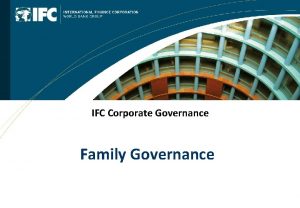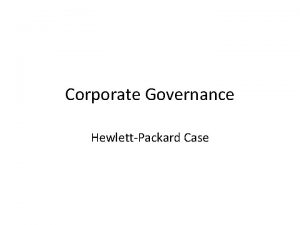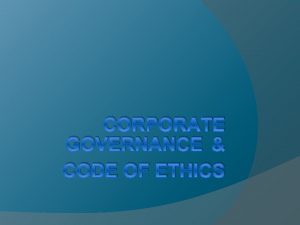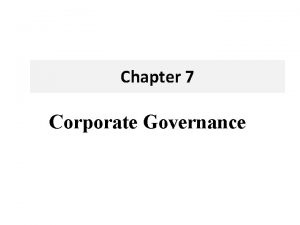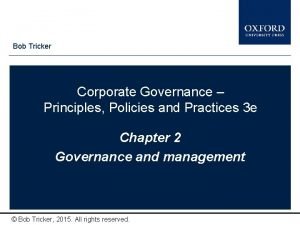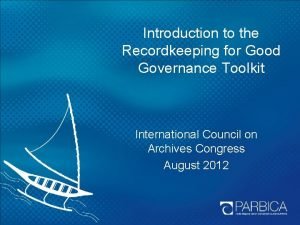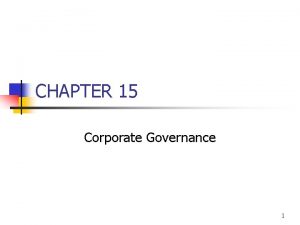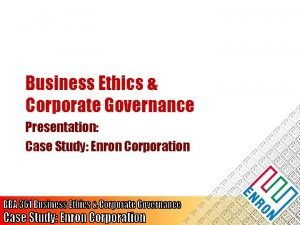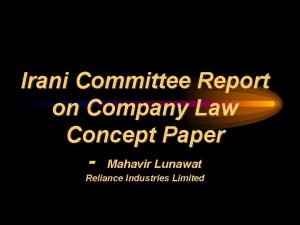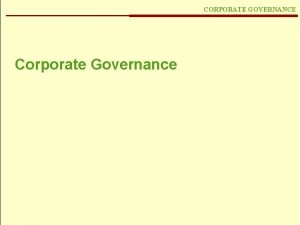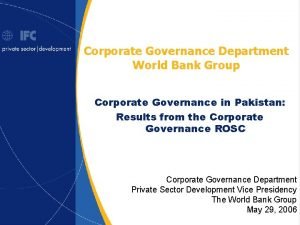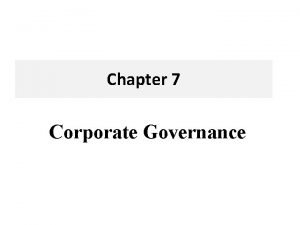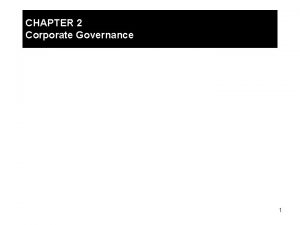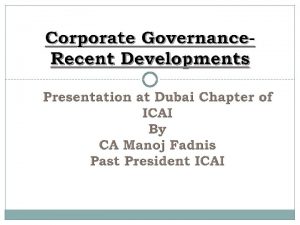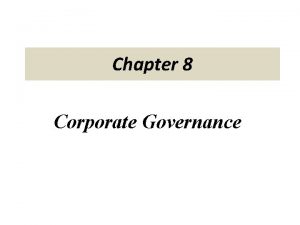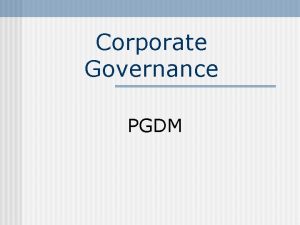Approaches to Corporate Governance Corporate Governance Approaches Rules


































- Slides: 34

Approaches to Corporate Governance

Corporate Governance Approaches Rules Based SOX Convergence of Governance Codes Ownership Models Principles Based OECD ICGN

Rules and principles based approaches to corporate governance � There are different approaches to the communication, management and monitoring of codes. Approaches to Corporate Governance Rule Based (Eg: US) Principle Based (Eg: UK)

Rules and principles based approaches to corporate governance � � A rules-based approach instills the code into law with appropriate penalties for transgression. A principles-based approach requires the company to adhere to the spirit rather than the letter of the code. The company must either comply with the code or explain why it has not through reports to the appropriate body and its shareholders. The UK model is a principles-based one, although since adherence is part of stock exchange listing requirements it cannot be considered to be voluntary for large companies. The US model is enshrined into law by virtue of SOX. It is, therefore, a rules-based approach.

Choice of governance regime The decision as to which approach to use for a country can be governed by many factors: � dominant ownership structure (bank, family or multiple shareholder) � legal system and its power/ability � government structure and policies state of the economy � culture and history � levels of capital inflow or investment coming into the country � global economic and political climate

Comply or explain �A principles-based code requires the company to state that it has complied with the requirements of the code or to explain why it could not do so in its annual report. � This will leave shareholders to draw their own conclusions regarding the governance of the company.

Arguments in favour of a rules-based approach (and against a principles-based approach) Organizations Perspective: � Clarity in terms of what the company must do – the rules are a legal requirement, clarity should exist and hence no interpretation is required. � Standardisation for all companies – there is no choice as to complying or explaining and this creates a standardised and possibly fairer approach for all businesses. � Binding requirements – the criminal nature makes it very clear that the rules must be complied with.

Wider stakeholder perspective � Standardisation across all companies – a level playing field is created. � Sanction – the sanction is criminal and therefore a greater deterrent to transgression. � Greater confidence in regulatory compliance.

Arguments against a rules-based approach (and in favour of a principles-based approach) Organisation’s Perspective � � � Exploitation of loopholes – the exacting nature of the law lends itself to the seeking of loopholes. Underlying belief – the belief is that you must only play by the rules set. There is no suggestion that you should want to play by the rules (i. e. no 'buyin‘ is required). Flexibility is lost – there is no choice in compliance to reflect the nature of the organisation, its size or stage of development. Checklist approach – this can arise as companies seek to comply with all aspects of the rules and start ‘box-ticking’.

� ‘Regulation overload’ – the volume of rules and amount of legislation may give rise to increasing costs for businesses and for the regulators. � Legal costs to enact new legislation to close loopholes. � Limits – there is no room to improve, or go beyond the minimum level set. � ‘Boxticking’ rather than compliance – this does not lead to well governed organisations.

Sarbanes Oxley (SOX) � In 2002, following a number of corporate governance scandals such as Enron and World. Com, tough new corporate governance regulations were introduced in the US by SOX. � SOX is a rules-based approach to governance. � SOX is extremely detailed and carries the full force of the law. � � SOX includes requirements for the Securities and Exchange Commission (SEC) to issue certain rules on corporate governance. It is relevant to US companies, directors of subsidiaries of US listed businesses and auditors who are working on US listed businesses.

Sarbanes Oxley (SOX) Accuracy of Financial Statements Increased Financial Disclosures Internal Control Report Audit Committee Restrictions on Dealing Audit Partner SOX Key points Auditor Independence

Sarbanes Oxley (SOX) � SOX Key Points ◦ Audit Committee: Company must have an Audit Committee, will be disallowed from trading if it does not have one. ◦ Internal Control Report: Annual Report must include statements concerning internal control systems in the company ◦ Accuracy of Financial Statements: Must have vouched for by CEO and CFO ◦ Increased Financial Disclosures: Financial reports to detail off balance sheet financing ◦ Restrictions on Dealing: Directors prohibited from dealing in shares at ‘sensitive times’ ◦ Audit Partner: Senior partner must be changed every 5 years ◦ Auditor Independence: Auditors are restricted in the additional services they can provide to an audit client

Key effects of SOX � personal liability of directors for mismanagement and criminal punishment � improved communication of material issues to shareholders � improved investor and public confidence in corporate US improved internal control and external audit of companies � greater arm's length relationships between companies and audit firms � improved governance through audit committees.

Negative reactions to SOX � Doubling of audit fee costs to organisations � Onerous documentation and internal control costs � Reduced flexibility and responsiveness of companies � Reduced risk taking and competitiveness of organisations � Limited impact on the ability to stop corporate abuse � Legislation little more. defines a legal minimum standard and

Divergent governance � The committees and codes of practice in the UK are implemented through the FSA and adherence is a requirement of listing on the stock exchange. � This raises the issue of how governance impacts on other types of organisational structure: � Nongovernmental � organisations (NGOs) � smaller listed companies � US companies � private or family companies � global organisations.

NGOs � Governance issues for NGOs are similar to those raised for public sector organisations since both are not for profit (NFP) structures � In general, there is a need for increased commercialisation in operations, the need to run the charity as a business for the benefit of all.

Smaller limited companies � There is a duty on all organisations to operate within the law and, for those of any given size, to produce audited accounts. � In governance terms, the agency problem does not tend to arise in private limited companies since shareholding is restricted and those with shares tend to have a direct involvement with the running of the firm.

Smaller limited companies � Particular problems arise due to the limited size of such concerns: � Despite this there is generally a perception that all companies should comply and, like all other companies, in order to foster the key need for improved communication, should either comply or explain through the Business Review. � role and numbers of NEDs � size of the board � use of audit and nomination committees.

Governance structures �A wider world view of governance requires consideration of the nature of ownership, power and control. Family structures (as opposed to joint stock): � A family structure exists where a family has a controlling number of shares in a company. This has potential benefits and problems for the company, and the other shareholders involved.

Governance structures � Fewer agency costs – since the family is directly involved in the company there are fewer agency costs. � Ethics – it could be said that threats to reputation are threats to family honour and this increases the likely level of ethical behaviour. � Fewer short-term decisions – the longevity of the company and the wealth already inherent in such families suggest long-term growth is a bigger issue.

Governance structures � Gene pool – the gene pool of expertise in owner managers must be questionable over generations. � Feuds – families fight, and this is an added element of cultural complexity in the business operation. � Separation – families separate and this could be costly in terms of buying out shareholding and restructuring.

Governance structures Insider-dominated structures (as opposed to outsider-dominated) � This is an extension of the same idea. Insiderdominated structures are where the listed companies are dominated by a small group of shareholders. These: � may be family owned � may be banks, other companies or governments � predominate in Japan and Germany.

Governance structures The close relationship suggests benefits including: � fewer agency problems and costs � lower cost of capital � greater access to capital � less likelihood of suffering short-termism � greater, stable expert input to managerial decisions.

Governance structures Problems include: � lack of minority shareholder protection (unlike protection in law in outsiderdominated structures) � opaque operations and lack of transparency in reporting misuse of power � the market does not decide or govern (shareholders cannot exit easily to express discontent).

International convergence � The competitiveness of nations is a preoccupation for all governments. � Harmonisation and liberalisation of financial markets mean that foreign companies now find it easy to invest in any marketplace. � This has led to a drive towards international standards in business practices to sit alongside the global shift in applying International Accounting Standards (IASs).

International convergence � Two organisations have published corporate governance codes intended to apply to multiple national jurisdictions. These organisations are: � Organisation for Economic Cooperation and Development (OECD) and the International Corporate Governance Network (ICGN).

International convergence Corporate Governance Codes for Multiple Jurisdictions OECD principles of Corporate Governance ICGN Statement on global Corporate Governance Principles

Organisation for Economic Cooperation and Development (OECD) � Established in 1961, the OECD is an international organisation composed of the industrialised market economy countries, as well as some developing countries, and provides a forum in which to establish and coordinate policies.

Organisation for Economic Cooperation and Development (OECD) � The OECD principles were updated and republished in 2004. Content of the OECD principles: � ensuring the basis for an effective corporate governance framework � the rights of shareholders and key ownership functions � the equitable treatment of shareholders � the role of stakeholders in corporate governance � disclosure and transparency � the responsibilities of the board.

International Corporate Governance Network (ICGN) � ICGN, founded in 1995 at the instigation of major institutional investors, represents investors, companies, financial intermediaries, academics and other parties interested in the development of global corporate governance practices.

International Corporate Governance Network (ICGN) � Content of the ICGN principles: � corporate objective – shareholder returns � disclosure and transparency � Audit � shareholders’ ownership, responsibilities, voting rights and remedies � corporate boards � corporate remuneration policies � corporate citizenship, stakeholder relations and the ethical conduct of business � corporate governance implementation.

International Corporate Governance Network (ICGN) � All codes are voluntary and are not legally enforceable unless enshrined in statute by individual countries. � Local differences in company ownership models may mean parts of the codes are not applicable.

Further Reading � Rules, principles and Sarbanes–Oxley � Corporate Governance and Credit Crunch � Economist: Reforming corporate governance
 Major approaches to corporate governance
Major approaches to corporate governance Corporate finance objectives
Corporate finance objectives Develop new approaches to public governance and engagement
Develop new approaches to public governance and engagement Power bi governance
Power bi governance Sociological theory of corporate governance
Sociological theory of corporate governance Corporate governance definitie
Corporate governance definitie Corporate governance chain
Corporate governance chain Informational and behavioral control
Informational and behavioral control Isu dan riset kontemporer corporate governance
Isu dan riset kontemporer corporate governance Corporate governance purpose
Corporate governance purpose Family governance definition
Family governance definition Corporate governance in sri lanka
Corporate governance in sri lanka Cmda corporate governance code
Cmda corporate governance code Hp corporate governance
Hp corporate governance P&g corporate governance
P&g corporate governance What is corporate governance
What is corporate governance Corporate governance in strategic management
Corporate governance in strategic management Tricker
Tricker Good governance pillars
Good governance pillars Corporate governance is a form of
Corporate governance is a form of Corporate governance tool kit
Corporate governance tool kit Good governance and corporate social responsibility
Good governance and corporate social responsibility Latar belakang munculnya gcg di indonesia
Latar belakang munculnya gcg di indonesia Corporate governance lecture
Corporate governance lecture Potential problems in corporate governance
Potential problems in corporate governance Examples of agency problems
Examples of agency problems Enron scandal presentation
Enron scandal presentation Cadbury committee report ppt
Cadbury committee report ppt Oecd corporate governance principles
Oecd corporate governance principles Oecd guidelines for corporate governance
Oecd guidelines for corporate governance Corporate governance definizione
Corporate governance definizione Jj irani committee recommendations
Jj irani committee recommendations Corporate governance reforms in india
Corporate governance reforms in india Corporate governance clause 49
Corporate governance clause 49 Scope of corporate governance
Scope of corporate governance










